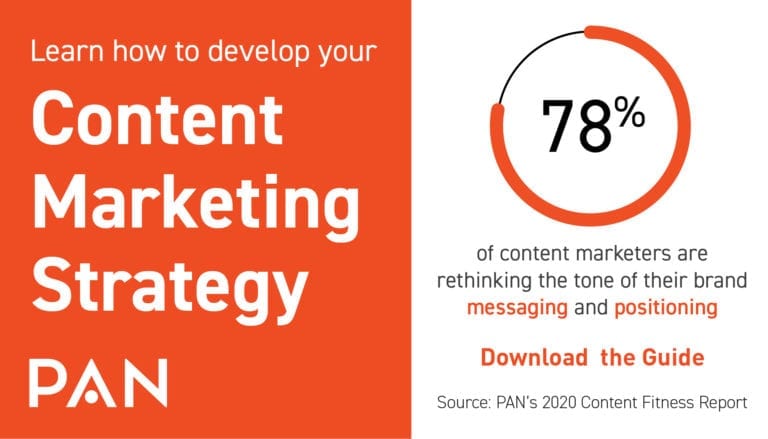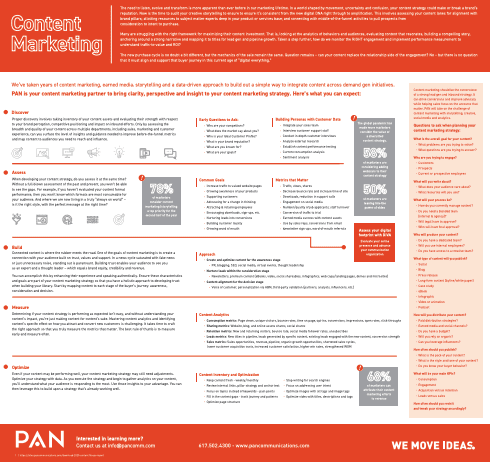This blog is the third in our series that focuses on the five-pillar approach to content marketing. Read below and continue to follow along in the coming weeks to learn how to bring your content from ideation to execution, and how to measure its impact along the way.
You’ve laid all the groundwork for a successful content marketing strategy. You’ve assessed past and present content deliverables, identified the performance gaps and started building a library of assets that map to buyer personas and each stage of the buyer’s journey. Now that you know how to cut through the noise, what are you going do to make sure your content reaches the right audiences?
Here’s where the real strategic work begins.
“Creating engaging content starts the process, but it’ll only take you so far. You need to develop a content distribution strategy to ensure it is landing in the right spots and delivering the value you expect.”
Creating engaging content starts the process, but it’ll only take you so far. You need to develop a content distribution strategy to ensure it is landing in the right spots and delivering the value you expect. What content vehicles should you focus on? How often should you post? Can you distribute the assets in such a way that they amplify one another? And how can you optimize your distribution strategy to ensure that it continues to deliver sustained value over time?
These are critical questions marketers should be asking as they progress through their own content marketing journeys. Here are a few steps they can take.

4 Steps to Content Marketing Optimization
#1: Determine the Right Mix
Companies have many options when it comes to developing a content distribution strategy. They could go heavy on owned media (high-value landing pages, blogs, newsletters), shared media (social media, partnerships with sites operated by a third party), and/or paid media (sponsored content). There are also different content vehicles – webinars, podcasts, multimedia, position papers, eBooks, etc. Every company has its own market, strengths and style. The right blend for one might not be the best for another.
“To determine the right media mix for your prospects, consider factors such as their audience’s characteristics, rules of engagement and communication style.”
To determine the right media mix for your prospects, consider factors such as their audience’s characteristics, rules of engagement and communication style. Where does your audience spend its time? How does it like to engage? Would your brand’s tone be a good fit for the platforms the audience prefers? And is your team – internal or external – structured to deliver content across the array of platforms you choose to target?
#2: Establish the Right Frequency
A “spray and pray” approach no longer serves your brand. Posting too often can exhaust resources and turn off your audiences. Conversely, leaving platforms untouched for long periods of time risks losing an audience altogether. Pay close attention to whether communities are receptive to your messages and responding positively. Consider time-in-market as well. Does the schedule you install for your inventory allow enough time in the field to be consumed, and subsequently cultivate engagement that will have a meaningful impact on your business?
Click to download the full framework.
#3: Promote Wisely
Once you figure out where to assign your content assets and when to deliver them, a successful delivery strategy needs promotion. In an ideal world, you can “sprinkle” pieces of content across channels, allowing one platform to steer an audience to another. The old adage “create once, use many times” delivers value here at this stage.
For example, say you have a podcast you want to promote. While the more commonly known mechanisms include social media, your blog and your website, there are other tactics at your disposal. Cut the audio up into a YouTube video, create a blog based on highlights from the Q&A and partner with the podcast guest to promote it on her channels. You wouldn’t promote an ebook the same way – cutting 30+ pages into a video would be too time consuming. An eBook focusing on similar content could be pushed through exit-intent pop-ups or paid social ads.
Content Check-In!
#4: Reassess and Recalibrate
Distribution strategies can – and often do – change over time. What works for a startup might not be the right approach for that same company as it moves up market in its growth stage. Content strategies that resonated last year may be entirely tone deaf this year. We’ll look more deeply into measurement tactics in the next blog. For now, the key takeaway is this: Evaluate your strategy, then reevaluate it using analytics and measuring against audience-specific KPIs you want to achieve.
Content marketing is a journey. Without a strategic approach to content distribution, companies can lose direction – quickly. Stay tuned for more as we continue to detail our best practices for content marketing.
Like what you’re reading? This blog is the third in a four-part series discussing all-things modern content marketing as part of a comprehensive, digitally agile framework PAN developed to serve as the cornerstone of your CM strategy. Data-driven and customer-centric, our five-pillar approach not only helps brands identify which content excites its audiences most but also answers why they are so hungry for it. Stay tuned for the next and final post in our series on measuring and optimizing your content for success.
Read the next blog here, or download the eBook here.





